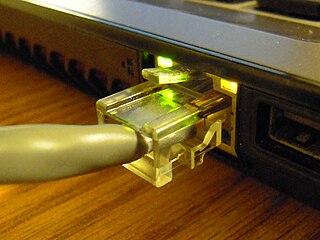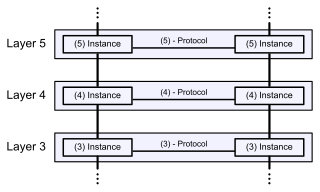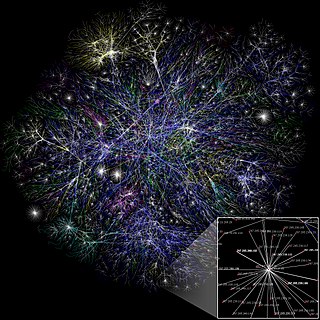Related Research Articles

Ethernet is a family of wired computer networking technologies commonly used in local area networks (LAN), metropolitan area networks (MAN) and wide area networks (WAN). It was commercially introduced in 1980 and first standardized in 1983 as IEEE 802.3. Ethernet has since been refined to support higher bit rates, a greater number of nodes, and longer link distances, but retains much backward compatibility. Over time, Ethernet has largely replaced competing wired LAN technologies such as Token Ring, FDDI and ARCNET.
Internetworking is the practice of interconnecting multiple computer networks, such that any pair of hosts in the connected networks can exchange messages irrespective of their hardware-level networking technology. The resulting system of interconnected networks are called an internetwork, or simply an internet.
Multiprotocol Label Switching (MPLS) is a routing technique in telecommunications networks that directs data from one node to the next based on labels rather than network addresses. Whereas network addresses identify endpoints, the labels identify established paths between endpoints. MPLS can encapsulate packets of various network protocols, hence the multiprotocol component of the name. MPLS supports a range of access technologies, including T1/E1, ATM, Frame Relay, and DSL.

The Open Systems Interconnection (OSI) model is a reference model from the International Organization for Standardization (ISO) that "provides a common basis for the coordination of standards development for the purpose of systems interconnection." In the OSI reference model, the communications between systems are split into seven different abstraction layers: Physical, Data Link, Network, Transport, Session, Presentation, and Application.

X.25 is an ITU-T standard protocol suite for packet-switched data communication in wide area networks (WAN). It was originally defined by the International Telegraph and Telephone Consultative Committee in a series of drafts and finalized in a publication known as The Orange Book in 1976.
In telecommunications, packet switching is a method of grouping data into packets that are transmitted over a digital network. Packets are made of a header and a payload. Data in the header is used by networking hardware to direct the packet to its destination, where the payload is extracted and used by an operating system, application software, or higher layer protocols. Packet switching is the primary basis for data communications in computer networks worldwide.
In the IEEE 802 reference model of computer networking, the logical link control (LLC) data communication protocol layer is the upper sublayer of the data link layer of the seven-layer OSI model. The LLC sublayer acts as an interface between the medium access control (MAC) sublayer and the network layer.
Packet Switch Stream (PSS) was a public data network in the United Kingdom, provided by British Telecommunications (BT). It operated from the late 1970s through to the mid 2000s.
Network congestion in data networking and queueing theory is the reduced quality of service that occurs when a network node or link is carrying more data than it can handle. Typical effects include queueing delay, packet loss or the blocking of new connections. A consequence of congestion is that an incremental increase in offered load leads either only to a small increase or even a decrease in network throughput.
A public data network (PDN) is a network established and operated by a telecommunications administration, or a recognized private operating agency, for the specific purpose of providing data transmission services for the public.
The CYCLADES computer network was a French research network created in the early 1970s. It was one of the pioneering networks experimenting with the concept of packet switching and, unlike the ARPANET, was explicitly designed to facilitate internetworking.

A computer network is a set of computers sharing resources located on or provided by network nodes. Computers use common communication protocols over digital interconnections to communicate with each other. These interconnections are made up of telecommunication network technologies based on physically wired, optical, and wireless radio-frequency methods that may be arranged in a variety of network topologies.
Telenet was an American commercial packet-switched network which went into service in 1975. It was the first FCC-licensed public data network in the United States. Various commercial and government interests paid monthly fees for dedicated lines connecting their computers and local networks to this backbone network. Free public dialup access to Telenet, for those who wished to access these systems, was provided in hundreds of cities throughout the United States.
DATAPAC, or Datapac in some documents, was Canada's packet switched X.25-equivalent data network. Initial work on a data-only network started in 1972 and was announced by Bell Canada in 1974 as Dataroute. DATAPAC was implemented by adding packet switching to the existing Dataroute networks. It opened for use in 1976 as the world's first public data network designed specifically for X.25.
A wireless ad hoc network (WANET) or mobile ad hoc network (MANET) is a decentralized type of wireless network. The network is ad hoc because it does not rely on a pre-existing infrastructure, such as routers or wireless access points. Instead, each node participates in routing by forwarding data for other nodes. The determination of which nodes forward data is made dynamically on the basis of network connectivity and the routing algorithm in use.
This article is about the Internet in Spain.
IEEE 802.1aq is an amendment to the IEEE 802.1Q networking standard which adds support for Shortest Path Bridging (SPB). This technology is intended to simplify the creation and configuration of Ethernet networks while enabling multipath routing.
The link layer is the lowest layer in the TCP/IP model. It is also referred to as the network interface layer and mostly equivalent to the data link layer plus physical layer in OSI. This particular layer has several unique security vulnerabilities that can be exploited by a determined adversary.

The NPL network, or NPL Data Communications Network, was a local area computer network operated by a team from the National Physical Laboratory (NPL) in London that pioneered the concept of packet switching.
TRAME was the name of the second computer network in the world similar to the internet to be used in an electric utility. Like the internet, the base technology was packet switching; it was developed by the electric utility ENHER in Barcelona. It was deployed by the same utility, first in Catalonia and Aragón, Spain, and later in other places. Its development started in 1974 and the first routers, called nodes at that time, were deployed by 1978. The network was in operation until 2016 with successive technological software and hardware updates.
References
- Jorge Infante, El desarrollo de la red pública de datos en España, Revista BIT del Colegio Oficial de Ingenieros de Telecomunicación, nº 136, 2002. (In Spanish)